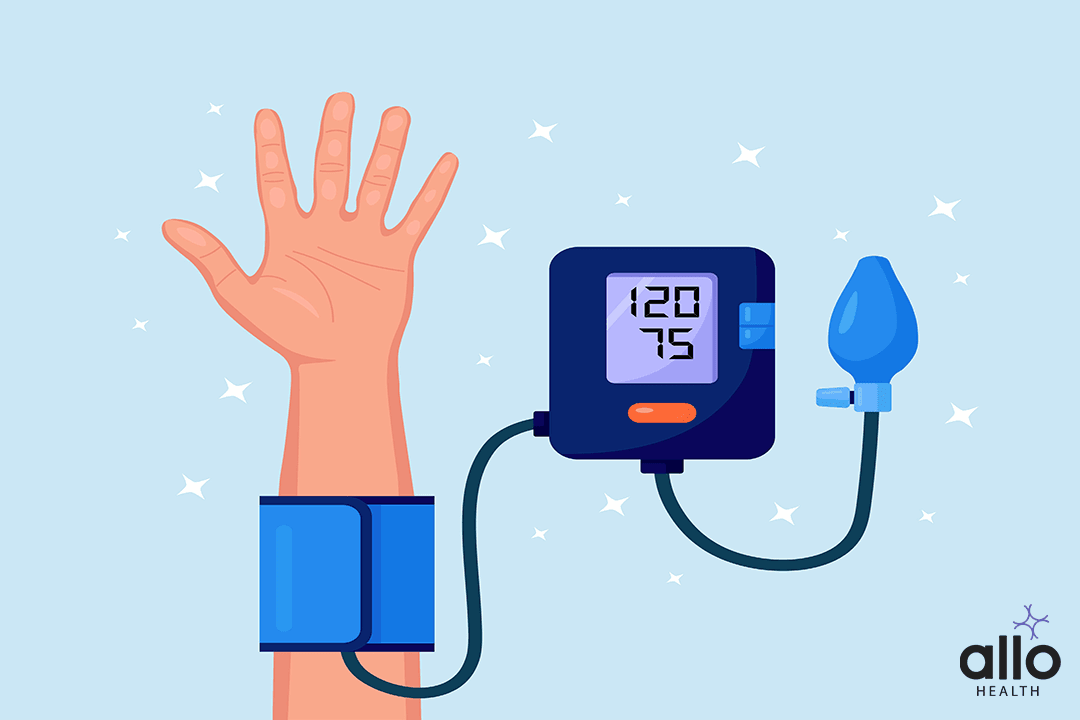Understanding Olmesartan: Effects on Erectile Dysfunction

Allo Health is dedicated to personalized well-being, offering support and trusted information tailored to individual health goals. The platform emphasizes human-generated content, led by a distinguished medical team of experts, including physicians and sexual health specialists. Their commitment to credibility involves rigorous fact-checking, authoritative research, and continuous updates to ensure accurate, up-to-date information. Allo Health's unique approach goes beyond conventional platforms, providing expert-led insights and a continuous commitment to excellence, with user feedback playing a crucial role in shaping the platform's authoritative voice.

Dr.Sushma.V completed MBBS degree from BGS GIMS,bangalore
Why This Was Upated?
Our experts continually monitor the health and wellness space, and we update our articles when new information became available.
Updated on 03 February, 2024
- Article was updated as part of our commitment to diversity, equity, and inclusion.

"The following blog article may discuss medical treatments and interventions. However, it is important to note that the information provided is for general educational purposes only and should not be considered as a substitute for professional medical advice, diagnosis, or treatment. Always seek the guidance of a qualified healthcare professional for personalized medical advice.
Book consultation
Medical treatments are complex and should be tailored to individual circumstances. The information presented in this blog may not be applicable to everyone, as each person's medical condition, history, and needs are unique. Only a qualified healthcare professional can evaluate your specific medical situation, consider relevant factors, and provide appropriate recommendations for diagnosis, treatment options, and monitoring.
It is crucial to note that self-diagnosis, self-medication, or relying solely on the information provided in this blog for treatment decisions can have serious health consequences. "
If you or a loved one takes Olmesartan for high blood pressure, you may have heard concerns about its possible link to Erectile Dysfunction (ED). While some suggested a connection between the medication and ED. It is important to understand the effects of Olmesartan on the body and consider potential risk factors before jumping to conclusions.
Understanding Olmesartan and its effects on the body
- Blood Pressure Regulation:
Olmesartan is prescribed to lower blood pressure.
It achieves this by blocking the action of angiotensin II, a hormone that narrows blood vessels.
- Relaxation of Blood Vessels:
The primary mechanism of Olmesartan is the relaxation of blood vessels.
This vasodilation reduces resistance, allowing blood to flow more easily and lowering blood pressure.
- Reducing Heart Workload:
By lowering blood pressure, Olmesartan decreases the workload on the heart.
This can be particularly beneficial for individuals with conditions such as hypertension or heart failure.
- Common Side Effects:
Dizziness:
A common side effect of Olmesartan is dizziness.
It may occur particularly when standing up quickly.
Headache:
Headaches are reported as a common unwanted effect.
These can vary in intensity and duration.
Stomach Pain:
Some individuals may experience stomach pain while taking Olmesartan.
It’s important to communicate any persistent discomfort to a health care professional.
- Severe Allergic Reactions:
In rare cases, Olmesartan can lead to severe allergic reactions.
Symptoms may include difficulty breathing and swelling of the face, lips, tongue or throat.
- Blood potassium level:
Potassium is essential for heart rhythm, nerves and muscles.
Low potassium (hypokalemia) can cause muscle weakness, irregular heartbeats, fatigue, constipation and more.
High potassium (hyperkalemia) can lead to irregular heartbeats, muscle weakness, nausea, tingling and even cardiac arrest. Maintaining the right potassium balance is crucial for health. 
Mechanism of Action of Olmesartan in Blood Pressure Control
- Blocking Angiotensin II:
Olmesartan is classified as an angiotensin II receptor blocker (ARB).
Angiotensin II is a hormone that naturally narrows blood vessels, contributing to an increase in blood pressure.
- Receptor Blockade:
Olmesartan works by selectively blocking the angiotensin II receptors.
It binds to the angiotensin II type 1 (AT1) receptors, preventing the hormone from exerting its vasoconstrictive effects.
- Vasodilation:
By blocking the action of angiotensin II, Olmesartan induces vasodilation.
Blood vessels relax, allowing for increased diameter and reduced resistance to blood flow.
- Reduced Sodium Retention:
Angiotensin II stimulates the release of aldosterone, another hormone.
Aldosterone promotes sodium retention by the kidneys, leading to increased fluid volume in the body.
- Decreased Fluid Buildup:
Blocking angiotensin II interrupts the aldosterone-mediated sodium retention.
As a result, Olmesartan helps to reduce fluid buildup in the body, decreasing overall blood volume.
- Decreased Workload on the Heart:
With vasodilation and reduced fluid retention, Olmesartan decreases the workload on the heart.
The heart pumps blood more efficiently against lower resistance and volume.
- Lowering Blood Pressure:
The combined effects of vasodilation, reduced sodium retention and decreased cardiac workload contribute to lowering blood pressure.
- Beneficial Effects on Cardiovascular Health:
Beyond blood pressure control, Olmesartan’s actions can be beneficial in managing conditions like hypertension and heart failure.
- Long-Term Maintenance:
Olmesartan is often prescribed for long-term use to maintain blood pressure within a target range.
Regular monitoring and adjustments by health care professionals help ensure optimal control.
Causes of Erectile Dysfunction (ED)
ED is often caused by physical factors, such as poor blood flow to the penis, nerve damage, or hormonal imbalances. Psychological factors, such as stress, anxiety, and depression, can also contribute to ED. Lifestyle factors, such as smoking, alcohol use and lack of exercise, can also increase the risk of developing ED.
Another potential cause of ED is certain medications, such as antidepressants, blood pressure medications and antihistamines. These medications can interfere with the body’s ability to achieve and maintain an erection.
In some cases, ED may be a symptom of an underlying medical condition, such as diabetes, heart disease or prostate cancer. It is important to speak with a healthcare provider if you are experiencing ED, as it may be an indication of a more serious health issue.
Research and studies on the link between Olmesartan and Erectile Dysfunction
Some have suggested a possible link between Olmesartan and Erectile Dysfunction and found that men taking Olmesartan were more likely to experience ED than those taking other blood pressure medications. However, other studies have not found a significant association between Olmesartan use and ED.
It is important to note that the link between Olmesartan and Erectile Dysfunction has been limited in scope and size. Further research is needed to fully understand the potential relationship between the two. In the meantime, individuals taking Olmesartan who experience ED should speak with their healthcare provider to discuss alternative treatment options.
Exploring the Link Between High Blood Pressure Medications and Erectile Dysfunction
High blood pressure drugs, including some antihypertensive medications, can increase the risk of erectile dysfunction (ED) through various mechanisms. Here are some ways in which these medications may impact sexual function:
- Vasodilation and Blood Flow:
Some antihypertensive medications, particularly those that dilate blood vessels, can affect blood flow, including to the genital area.
While they aim to improve overall cardiovascular health, the vasodilatory effect may also impact the ability to achieve and maintain an erection.
Beta-Blockers:
Beta-blockers, commonly prescribed for hypertension, may reduce the force of the heart’s contractions and lower the heart rate.
This can potentially lead to decreased blood flow to the penis, affecting erectile function.
- Diuretics:
Diuretics or water pills are another class of medications used to treat high blood pressure.
They can lead to dehydration and imbalances in electrolytes, potentially affecting sexual function.
- Hormonal Changes:
Some antihypertensive medications may influence hormonal levels, including testosterone.
Changes in hormonal balance can contribute to sexual dysfunction.
- Psychological Factors:
Knowing that high blood pressure drugs may have sexual side effects can contribute to performance anxiety and psychological stress, further impacting sexual function.

Balancing High Blood Pressure Control and Erectile Health: Strategies to Prevent Erectile Dysfunction
- Consult Healthcare Provider:
Discuss ED concerns with your healthcare provider.
Consider adjustments to blood pressure medication, if needed.
Lifestyle Changes:
Engage in regular exercise and maintain a healthy diet to support cardiovascular health.
Practice stress-reducing activities like meditation or yoga.
Avoid Smoking and Limit Alcohol:
Quit smoking to protect blood vessels.
Limit alcohol intake to moderate levels.
- Regular Check-ups:
Attend regular health check-ups to monitor blood pressure and address concerns.
Seek psychological support if stress or anxiety affects blood pressure or ED.
Alternative medication options for managing high blood pressure
- ACE Inhibitors (Angiotensin-Converting Enzyme Inhibitors):
Examples include enalapril, lisinopril and ramipril.
ACE inhibitors reduce the production of angiotensin II, a hormone that narrows blood vessels.
- Calcium Channel Blockers:
Examples include amlodipine, nifedipine and diltiazem.
Calcium channel blockers relax blood vessels by preventing calcium from entering cells.
- ARBs (Angiotensin II Receptor Blockers):
While Olmesartan is an ARB, alternative medications within this class may be considered.
Examples include losartan, valsartan and candesartan.
- Beta-Blockers:
Examples include metoprolol, atenolol and carvedilol.
Beta-blockers reduce heart rate and the force of heart contractions.
- Thiazide Diuretics:
Examples include hydrochlorothiazide, chlorthalidone and indapamide.
Thiazide diuretics increase urine production, reducing fluid volume and blood pressure.
Benefits of Olmesartan
- Effective Blood Pressure Control:
Olmesartan lowers blood pressure by relaxing blood vessels.
Cardiovascular Protection:
Reduces the risk of heart attack and stroke by managing hypertension.
- Kidney Protection:
Preserves kidney function, particularly in individuals with diabetes and high blood pressure.
- Stroke Prevention:
Contributes to preventing strokes by maintaining optimal blood flow to the brain.
- Heart Failure Management:
Used in managing heart failure and improving cardiac function.
- Tolerability:
Generally well-tolerated with a favorable side effect profile.
- Once-Daily Dosage:
A convenient dose of Olmesartan in once-daily administration enhances medication adherence.
- Combination Therapy Options:
Can be part of combination therapy for optimal blood pressure control.
Patient perspectives and experiences related to Olmesartan and ED
While some individuals taking Olmesartan have reported experiencing ED, others have not noticed any changes in sexual function. It’s essential to talk to a healthcare provider about any symptoms or sexual side effects you may experience while taking Olmesartan or any other medication.
It is important to note that erectile dysfunction can have various causes, including underlying medical conditions, psychological factors and lifestyle habits. Therefore, it is crucial to undergo a thorough medical evaluation to determine the root cause of ED before attributing it solely to Olmesartan or any other medication.
Conclusion:
While some have suggested a possible link between Olmesartan and ED, it’s essential to understand the risks and benefits of the medication and discuss any concerns with a healthcare provider. Several factors can contribute to ED, and medication use is only one of them. Making lifestyle changes, such as exercise and a healthy diet, can help reduce the risk of ED, regardless of medication use. If you or a loved one is experiencing ED or has concerns about medication use, talk to a healthcare provider for medical advice.
It’s important to note that not everyone who takes Olmesartan will experience ED. Many people take the medication without any adverse effects on their sexual function. Additionally, if you are experiencing ED while taking Olmesartan, it’s possible that the medication is not the sole cause. Other factors, such as age, stress and underlying medical conditions, can also contribute to ED. Therefore, it’s crucial to have an open and honest conversation with your healthcare provider to determine the underlying cause of your symptoms and develop an appropriate treatment plan.
Most Asked Questions
-
Is there a confirmed link between Olmesartan and Erectile Dysfunction (ED)?
While some studies have suggested a possible link between Olmesartan and ED, the evidence is not conclusive. Some individuals taking Olmesartan have reported experiencing ED, but others have not noticed any changes in sexual function. Further research is needed to fully understand the potential relationship between Olmesartan and ED. If you are experiencing ED while taking Olmesartan, it's important to consult your healthcare provider to discuss your specific situation and explore alternative treatment options.
-
What are the common side effects of Olmesartan and how can they be managed?
Common side effects of Olmesartan may include dizziness, headaches, stomach pain, and in rare cases, severe allergic reactions. To manage these side effects, it's essential to communicate any persistent discomfort to your healthcare provider. They can adjust your medication or suggest strategies to minimize side effects. It's crucial to follow your healthcare provider's guidance and not discontinue the medication without their approval.
-
How does Olmesartan work to control high blood pressure?
Olmesartan is classified as an angiotensin II receptor blocker (ARB). It lowers blood pressure by blocking the action of angiotensin II, a hormone that naturally narrows blood vessels. This action leads to vasodilation, where blood vessels relax, reducing resistance to blood flow. Olmesartan also reduces sodium retention, decreases fluid buildup, and decreases the workload on the heart. These combined effects help lower blood pressure and are beneficial in managing conditions like hypertension and heart failure.
-
What are the potential causes of Erectile Dysfunction (ED) besides medication use?
ED can have various causes, including physical factors such as poor blood flow to the penis, nerve damage, hormonal imbalances, and psychological factors like stress, anxiety, and depression. Lifestyle factors such as smoking, alcohol use, and lack of exercise can also contribute to ED. Additionally, underlying medical conditions like diabetes, heart disease, or prostate cancer can be underlying causes of ED. It's important to consult with a healthcare provider to determine the specific cause and appropriate treatment for ED.
-
Are there alternative blood pressure medications that may have fewer side effects related to ED?
Yes, there are alternative blood pressure medications available, including ACE inhibitors (e.g., enalapril, lisinopril), calcium channel blockers (e.g., amlodipine, nifedipine), other ARBs (e.g., losartan, valsartan), beta-blockers (e.g., metoprolol, atenolol), and thiazide diuretics (e.g., hydrochlorothiazide). These medications have different mechanisms of action and may have varying side effect profiles. It's important to work closely with your healthcare provider to determine the most suitable medication for your blood pressure management, taking into consideration any potential side effects and individual health factors.






































